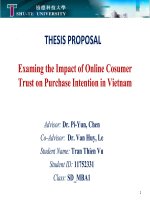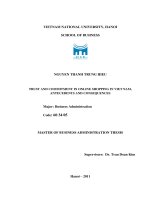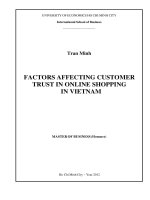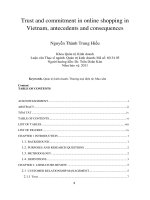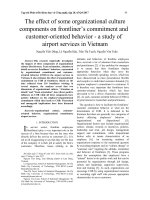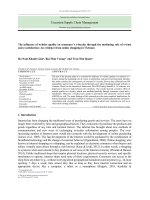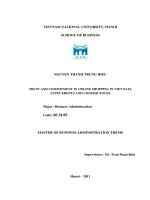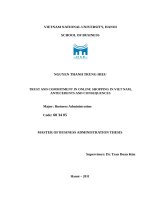Trust and commitment in online shopping in Vietnam, antecedents and consequences
Bạn đang xem bản rút gọn của tài liệu. Xem và tải ngay bản đầy đủ của tài liệu tại đây (2.21 MB, 96 trang )
VIETNAM NATIONAL UNIVERSITY, HANOI
SCHOOL OF BUSINESS
NGUYEN THANH TRUNG HIEU
TRUST AND COMMITMENT IN ONLINE SHOPPING IN VIET NAM,
ANTECEDENTS AND CONSEQUENCES
Major: Business Administration
Code: 60 34 05
MASTER OF BUSINESS ADMINISTRATION THESIS
Supervisors: Dr. Tran Doan Kim
Hanoi – 2011
vi
TABLE OF CONTENTS
ACKNOWLEGEMENT i
ABSTRACT ii
TÓM TẮT iv
TABLE OF CONTENTS vi
LIST OF TABLES viii
LIST OF FIGURES ix
CHAPTER 1 INTRODUCTION 1
1.1. BACKGROUND 1
1.2. PURPOSES AND RESEARCH QUESTIONS 2
1.3. METHODOLOGY 2
1.4. DEFINITIONS 3
CHAPTER 2: LITERATURE REVIEW 5
2.1 CUSTOMER RELATIONSHIP MANAGEMENT 5
2.1.1 Trust 7
2.1.2. Commitment 11
2.1.3 Loyalty 16
2.1.4 Retention 17
2.1.5 The relationship among commitment, trust, loyalty and retention 17
2.2 METHOD OF STATISCAL ANALYSIS 24
2.2.1 Correlation analysis 24
2.2.2 Multiple Regression 24
CHAPTER 3: METHODOLOGY 30
3.1 RESEARCH STRATEGY 30
3.2 DATA COLLECTION METHOD 32
vii
3.2.1 Sample size 32
3.2.2 Questionnaire design 33
3.2.3 Data collection 36
3.3 DATA ANALYSIS 37
3.3.1 Measurement of variables 37
3.3.2 Independent variables 37
3.3.3 Dependent Variables 38
3.3.4 Methods of data analysis 39
CHAPTER 4: FINDINGS AND CONCLUSION 40
4.1 DESCRIPTIVE STATISTICS 40
4.2 CORRELATIONS 41
4.3 HYPOTHESIS TESTING 42
4.3.1 The determinants of Trust 43
4.3.2 The determinants of Commitment 45
4.3.3 The determinants of Customer Loyalty 48
4.3.4 The determinants of Customer Retention 54
CHAPTER 5: CONCLUSION AND RECOMMENDATIONS 62
5.1 DISCUSSION 62
5.2 IMPLICATIONS 65
5.3 RECOMMEDATIONS 67
5.3.1 Further research 67
5.3.2 For e-commerce in Vietnam 68
REFERENCES 89
viii
LIST OF TABLES
Table 3.1: Independent Variables 38
Table 3.2: Dependent Variables 38
Table 4.1 Descriptive Statistics of Scales 41
Table 4.2 Correlation Matrix 42
Table 4.3 The Determinants of Trust 43
Table 4.4 Regression Diagnostics – Trust 45
Table 4.5 The Determinants of Commitment 46
Table 4.6 Regression Diagnostics – Commitment 48
Table 4.7 The Direct Determinants of Customer Loyalty 49
Table 4.8 Regression Diagnostics – Customer Loyalty 50
Table 4.9 The Determinants of Customer Loyalty 52
Table 4.10 Regression Diagnostics –Customer Loyalty 53
Table 4.11 The Direct Determinants of Customer Retention 55
Table 4.12 Regression Diagnostics - Customer Retention 56
Table 4.13 The Determinants of Customer Retention 58
Table 4.14 Regression Diagnostics –Customer Retention 60
ix
LIST OF FIGURES
Figure 2.1 Model of determinants of customer loyalty and retention for online
shopping (research framework) 23
1
CHAPTER 1 INTRODUCTION
1.1. BACKGROUND
The Internet‟s success over a few decades has changed many things in today‟s
social life. People now can communicate virtually and can buy virtually
anything without going to the stores or supermarket. E-commerce in general
and shopping online in particular has helped companies gain a new effective
distribution channels beyond traditional ones and has also helped customers
save their time. As a result, shopping online has developed exponentially with
the evidence of rapidly increasing the revenues from e-business and the
number of trading transactions through Internet.
In Vietnam, e-commerce is one of those areas receiving support from the
government. In the Ministry of Industry and Trading, there is an E-commerce
Development Centre which observes, analyze the development of e-
commerce and finds various solutions to further develop e-commerce in
Vietnam. They post annual reports on the Vietnam e-commerce situation.
The number of enterprises applying for e-business in Vietnam increased
gradually from 8% to 12% in the period of 2006 – 2009 according to the
reports of E-commerce Development Centre in 2009. In other words, many
products will be supplied through Internet and customers in Vietnam can buy
goods by searching without going to supermarket or stores like at the present.
However, traditional buying habits have with many characteristics such as the
close relationship between buyers and sellers where buyers can communicate
and ask sellers about products or sellers can introduce new products through
the many convenience stores in Vietnam. These may create barriers to the
development of online business in Vietnam. Other barriers preventing
shopping online in Vietnam such as electronic payment systems, supplied by
banks and network systems companies also are mentioned in the media.
2
1.2. PURPOSES AND RESEARCH QUESTIONS
E-commerce in Vietnam has government and commercial enterprise attention
but the number of customers shopping online is still limited. People are not
yet ready to trade online. Moreover, with the limited number of current
customers, what should companies do to keep them and develop close
relationships with them? How can companies ensure customer product
repurchase or recommend others people to use them?
Most research in Vietnam focuses on the development of e-commerce from
the point of view of the companies applying, but rarely studies how to attract
and keep customers shopping online. Therefore, the objective of this research
is to explore the relationship between trust, commitment, loyalty and
retention, the four main areas identified in various previous studies on
customer relationship marketing. Based on such relationship patterns, the
research will discuss which factors influence customer loyalty and customer
retention and recommend how to encourage and keep customers shopping
online in Vietnam. From the objectives of the research, two research
questions emerged and can be stated as following.
1. What are the antecedents of trust and commitment?
2. How do trust and commitment influence customer loyalty and customer
retention in online shopping in Vietnam?
1.3. METHODOLOGY
The objective of research is to test the hypothesis to find out the relationship
between variables in online shopping in Vietnam lending to a deductive
research approach and the research purpose is explanatory.
The research will start with a literature review which reviews the theories
related to the topic researched to investigate often studied areas in customer
3
relationship in marketing areas and to develop hypotheses for this research.
According to the recommendations of the research method, a survey strategy
with questionnaire is chosen to find the answers to the research questions.
A questionnaire is then built for data collection with 28 questions adapted
from previous research (the questionaire included many questions from other
many previous research- not from only one paper) to measure both
independent and dependent variables. A pilot test is used to make sure the
participants and researchers understand the meaning of questions.
The data collected are analyzed by the SPSS program. Firstly, it will be
checked whether distribution normally or not and then statistics calculate by
running correlations and multiple regressions to determine if the hypotheses
stated in this research are supported or rejected which are reflected the
relationships among four main areas are the same or different with current
studies.
1.4. DEFINITIONS
The research is going to tests the relationship between customer trust,
customer commitment, customer loyalty and customer retention, stated key
components in theories of customer relationship management and these
relationships will be tested in one particular business sector, namely; e-
commerce and online shopping in particular. Several concepts need to be
defined for the research.
Payne and Frow (2005) defined Customer relationship management
(CRM) as “a strategic approach that is concerned with creating improved
shareholder value through development of appropriate relationships with key
customers and customer segments. CRM unites the potential of relationship
marketing strategies and IT to create profitable, long term relationships with
4
customers and other key stakeholders. CRM provides enhanced opportunities
to use data and information to both understand customers and co-create value
with them. This requires a cross-functional integration of processes, people,
operations and marketing capabilities that is enabled through information,
technology and applications”
Turban and King (2003) defined E-commerce (EC) as “the process of
buying, selling, or exchanging products, services, and information via
computer networks, including the Internet”
Mosuwe et.al (2004) defined ”Shopping online means customer
intentions to shop on the Internet It refers to the way people buy products
through Internet from companies having e-business. It belongs to the type of
business to customers (B2C) within the larger concept of e-commerce”.
Morgan and Hunt (1994) defined Trust as “the perception of confidence
in the exchange partner‟s reliability and integrity”.
Morgan and Hunt (1994) defined “Commitment as an enduring desire to
maintain a valued relationship. It is the commitment in the mind of the
customer towards the company and the maintainance of the relationship
between them”.
Oliver (1999) defined “Customer loyalty as a deeply held commitment to
re-buy or re-patronize a preferred product/service consistently in the future,
thereby causing repetitive same-brand or same brand-set purchasing, despite
situational influences and marketing efforts having the potential to cause
switching behavior”
Gerpott (2001) defined Customer retention as “maintaining the business
relationship established between a supplier and a customer” .
5
CHAPTER 2: LITERATURE REVIEW
This chapter reviews literature relating to the research questions and
hypotheses of this study. First, the chapter begins with a summary of the
definition of customer relationship management (CRM). Then, the
relationships of four areas of CRM including trust, commitment, loyalty and
retention are discussed. The theoretical evidence of impact of factors on these
four areas is provided. After reviewing the literature related to variables in
customer relationship management, the research model has been developed as
a research framework . The research framework includes two main hypothese
parts: nine main hypotheses (from all types of H1 to H4 hypothese) to test the
different relationship between variables and 10 additional hypotheses (from
all types of H5 to H6 hypothese) are developed to test the role of mediator of
trust and commitment in the model. The research framework of this study is
the synthesis of the findings of previous authors in order to explain the
reserch problems. The research of this paper has conducted in Vietnam.
Therefore, the results of this study will have certain significance.
2.1 CUSTOMER RELATIONSHIP MANAGEMENT
Payne and Frow (2005) defined “CRM is a strategic approach that is
concerned with creating improved shareholder value through development of
appropriate relationships with key customers and customer segments. CRM
unites the potential of relationship marketing strategies and IT to create
profitable, long term relationships with customers and other key stakeholders.
CRM provides enhanced opportunities to use data and information to both
understand customers and cocreate value with them. This requires a cross-
6
functional integration of processes, people, operations, and marketing
capabilities that is enabled through information, technology, and
applications”. This definition is quite complete because it shows the
constituent activities of CRM and how CRM is incorporated in companies.
Since the concept of CRM appears mid-1990s, CRM has gone through three
generations in the development of this area. According to Kumar and
Reinartz (2006). the author has studied many of the CRM noted in his
research stated that “The first generation functional CRM‟s approach was
used as a way to increase sales and improve the services. CRM at that time
identified different activities such as sales force automation or customer
services and support”. And, the next gerenation of CRM is “customer-facing
front end approach‟‟. At that time, CRM was considered as the way to fill the
gaps in enterprise resource planning (ERP) functionality and the company‟s
business needs, namely; the customer-facing front end. Customer relationship
management through interaction with customers before selling to after sales
through the means of communication such as telephone or internet is not
achieved goal in 1990s.
By the end of 2002, strategic approach to the third generation began when the
company had to draw experience from the implementation of unsucssessful of
the old version of CRM. So, they not only focused on customer-facing front-
end, as in second generation, but also paid attention to back-end systems,
namely partners and suppliers. Evently, they integrated both of them with
Internet technology. Therefore, CRM at the moment is not only a technology
solution but also is the company's strategy. As the result, CRM plays as an
important role in the growth of the revenue line in a company.
7
2.1.1 Trust
2.1.1.1 Definition of trust
Because uncertainties exist in transactions though the Internet, many
researchers have stated that trust is an important factor influences the
successful developing of e-commerce. So, trust is consider as an important
role in many social and economic interactions relating to uncertainty and
dependency. In addition, There are two important factors influenced by
Trust in online transactions, which are the security and privacy, so the
concept trust is very important to defined.
Besides the convenience of e-commerce by bringing buyers and sellers also
have limitations such as lack of direct communication between buyers and
sellers, between buyers and goods. In order to reduce the barriers, supplier
need to develop a trustworthy relationship to increase customer loyalty.
Moreover, Teo & Liu ( 2007) considered “Consumer trust as an important
aspect of e-commerce, and understanding its antecedents and consequences
is a prime concern for the following reasons. First, the antecedents of trust
enable us to know the relative importance of factors affecting trust.
Understanding these factors would play an important role in devising
appropriate measures to facilitate trust. Second, the consequences of trust
would enable us to better understand the importance of trust and its effect
on online buying behaviour”.
In term of the organizational trust literature, Mayer et al. (1995) who
presented “a model realtionship between a trusting party and a party to be
trusted”. In term of e-commerce, Jarvenpaa et al. (2000) “ examined
8
whether or not customers‟ perceptions of an Internet store's reputation and
size affect their trust in the store. So, researchers find out that trust has
affect on consequences such as: consumers‟ attitudes, intentions, and
behaviors”.
Morgan and Hunt (1994) defined Trust as “the perception of confidence in the
exchange partner‟s reliability and integrity”. It means that Trust is one of the
most important factors for successful marketing relationships. The other
definition from Mayer et al (1995, p.712) as “trust is a willingness of a party
to be vulnerable to the actions of another party based on the expectation that
the other will perform a particular action important to the trustor, irrespective
of the ability to monitor or control that other party”. Based on the definitions
of trust from different previous studies, it can be seen that confidence and
reliability are two basic elements.
Although both the original concept of the trust, the definition does not include all
the dimensions of trust, because it is a very broad concept. So when research is
therefore trust need to classify based on the belief from analysis and comparison
of definition of trust, different classifications based on different definitions
according to factors such as attitudes, beliefs, behaviors and tendencies or to
different referents believe in trust, something in someone or trust in a specific
characteristic of someone as honest.
To sum up, we should need to be summarized into overall definition, so for this
study we use the definition of Morgan and Hunt (1994) - Trust as “the
perception of confidence in the exchange partner‟s reliability and integrity” .
2.1.1.2 Antecedents of trust
To answer one of part of the reasearch question such as: “ What are the
9
antecedents of Trust? ”, this research find out that there are two foundational
antecedents of trust studied through several previous research including e-
retailer reputation and Trust which were done by Bennett & Gabriel ( 2001);
Josang et al., (2007) and privacy concern and Trust by Eastlick (2006). Then,
this study will discuss about these antecedents of trust and the relationship
among them.
E-retailer reputation
There are many factors affecting the decision to participate in electronic
commerce, in which the reputation of the retailer is an important factor.
Following to Bennett & Gabriel (2001), who defined as: “E-retailer
reputation is same meaning as brand reputation which includes name, term,
symbol, sign or design to realize goods and services of one retailer with others
which provide the same items , and reputation is not only related to the image
features but also involves an outsider‟s subjective judgment of an
organization‟s qualities in terms of its past performance‟‟
Van and Leunis (1999) showed that “brand reputation is one of the factors
reducing customers‟ risk concerns when trading online through the Internet”.
E-retailer reputation is an important factor affecting customer decision to
participate in e-commerce. Especilly, Bennett and Gabriel, (2000) and
Josang et al (2007) stated “ Other research show the relationship between
reputation and trust in which reputation influences positively on customer
trust”. That is one of theoretical evidence related to this topic in term of
building and testing hypotheses.
The reputation of a company or an organization, even a category of
individuals is a very sensitive and vulnerable to bad because creating a good
reputation is very difficult compared with losing it. This is a strategic asset
10
very fragile but easily tarnished or damaged if not carefully protected.
Therefore, a supplier with good reputation, the more so the higher
consciousness to the protection of his reputation before the negative effects.
In the traditional marketing literature, reputation has proved to be positive
factors related to the confidence of buyers and sellers. Especilly, from
research of Teo & Liu (2007), stated that “ In Internet shopping, perceived
reputation of a vendor has also been revealed to be significantly related to
consumers‟ trust in the vendor”. That is one of theoretical evidence related to
building and testing the relationship betweene e-retailer reputation and
customer trust.(Mentioned in the hypothes H1a).
Privacy concerns
The privacy concerns is used in this study refer to a major source of consumer
concern surrounding the personal data, specific individuals, for example,
name, address, demographic characteristics, lifestyle, interests, shopping
preferences, purchase history of individuals.
There is one of barries to online shopping, which related to risk information,
important issue when studying the electronic commerce via internet, customer
may loss of privacy and the security of personal information.The information
is such as: personal information, collection information, unauthozied
secondary used personal information, mistaken personal information. The
information also refer to information privacy concern issues involving to
online marketing and shopping topic.
With the development of database technology and the explosion of
Internet, the privacy concerns of consumers that would arise when the
market research, customers consolidate all customer information. Meanwile,
11
Milne and Boza (1998) checked the ”relationship between privacy concerns
of consumers and trust toward marketing information practices across
different industries including direct marketing”. They reported that, with
“various industry, consumer reviews at an average of concerns about privacy
concern and low levels of trust for the information practices of marketers
directly”. (A modern marketing which using up existing tools to satisfy every
customer target). The report also said that, “by using multiple regression
techniques in statistics, they also found a negative relationship between trust
level for an exhibition of direct marketing and potential risk of loss of
privacy concern and sercurity of personal information” . With regard to online
retailing, it is expected that the relationship between privacy concerns and
trust in an e-retailer will be similar to that observed for other direct marketers.
(privacy concern negative affectly to trust). That is one of theoritical evidence
related to this topic in term of building and testing hypotheses about
relationship betweene privacy concerns and customer trust (mentioned in the
hypothes H1b).
2.1.2 Commitment
2.1.2.1 The definition of commitment
There are different definitions of commitment. Morgan and Hunt (1994)
defined as : “ Commitment is considered as „an enduring desire to maintain a
valued relationship‟‟. However, there is no single general form of
commitment as in the definition but also many forms of commitment that
create different actions. Though many the related literatire review, there are
other three forms commitment such as: Personal commitment, Moral
commitment and Structural commitment. Moreover, Allen and Meyer (1990)
defined commitment into three aspects like: “(1) affective commitment; (2)
12
normative commitment; and (3) continuance commitment. Affective
commitment refers to the feeling of belonging and the sense of attachment to
the organization. Continuance commitment concerned with perceived costs of
leaving both financial and non-financial and is perceived from lack of
alternatives. Normative commitment relates to the obligation that members
feel to remain with an organization and build on generalized cultural
expectations”.
But this is a model of commitment for organizations which does not focus on
customer commitment. Therefore, this research is going to conduct a test on
an interrelationship among four areas making it excessively complicated if
each area is divided into three components. Thus for the purposes of this
thesis, the definition of commitment by Morgan and Hunt (1994) will be
used- “ Commitment is considered as „an enduring desire to maintain a
valued relationship‟‟.
Commitment also is considered as the important factor of partnership success
and the first vital component of relationship capital. According to Morgan and
Hunt (1994), “commitment is the motivation to maintain the relationship and
the length of the relationship. A longer relationship implies a certain degree
of commitment between the two parties. When normative commitment exists
between channel members, firms would share mutual goals and values;
therefore, these firms would work closely in order to achieve both their
individual and joint goals”. Thus, normative commitment may increase the
closely held in the channel members.
2.1.2.2 Antecedents of commitment
Commitment has three main antecedents consisting of alternative
attractiveness, switching cost and customer satisfaction which base on the
13
previous research of many authors such as : Ping (1993), Whitten and Wake
Field (2006), M. Porter (1980), Anderson & Narus (1984 ) and Wetzels et al.
(1998).
Alternative attractiveness
Follow Ping (1993) “ Alternative attractiveness refers to clients estimates of
the likely satisfaction available through an alternative relationship another
with other companies”. In this research, alternative attractiveness signifies
any attractive offers made to customers from other e-retailers supplying the
same times. That is one of theoretical evidence related to this topic.
(Mentioned in hypothes H2a).
Switching costs
In term of economics literature, Whitten and Wake Field (2006) defined “
switching costs are defined as strategic relationship-between buyers and
suppliers that may be classified into three categories: learning costs,
transaction costs and contractual costs”. This paper encompasses these prior
definitions to “define switching costs as the economic and relational costs of
discontinuing a service relationship”.
The study mainly emphasizes economic theory conversion means sharing
costs and competitive market. However, mathematical models are used to
show that switching costs in developed markets lead to increased prices, and
monopoly rents, and prone to competition in the new market. In a dynamic
model, switching costs are shown to encourage new market entrants even
though such entry is inefficient.
In buyer–supplier relationships, switching costs are defined as an overall cost
14
or difficulty of switching, additional cost and effort in changing suppliers, an
undefined component of termination and investments that inhibit change.
switching costs in service relationships include perceptions of time, effort,
and money in changing service providers, perceived economic and
psychological costs, perceived disutility, and onetime costs associated with
switching providers. In a sum, the literature defines and operationalizes
switching costs in terms of economic (for example: monetary) expenditures
and intangible (for example, psychological or relational) costs associated with
changing an exchange relationship. The categorization of switching costs has
evolved from broad descriptions of cost (for example, economic or
psychological) to specific costs (for example, search and evaluation costs or
set-up costs) to more definitively understand and study the construct.
M. Porter (1980) defined switching costs as “ the costs of switching from one
supplier‟s product to another supplier‟s product” . Additional cost are such as:
search costs, transaction costs, learning costs, customers‟ habits, emotional
costs and cognitive effort in the switching cost construct. Thus” switching
costs include both economic and psychological values which affect
relationship-between buyers and suppliers in term of customer comitment”.
That is one of theoritical evidence related to this topic in term of building and
testing hypotheses about relationship betweene switching cost and customer
commitment. (Mentioned in the hypothes H2b)
Customer satisfaction
Methlie and Nyseen (1999) in their studies defined customer
satisfaction as “ the perception of customer about how product performing.
As such customer satisfaction is a result when comparing customer perception
of product performance and expectations”.
15
Anderson & Narus (1984 ) defined as “Satisfaction is a positive affective state
resulting from the appraisal of all aspects of a firm working relationship with
another firm”. Consistent with this view, satisfaction encompasses economic
and non-economic components but the relation between economic and non-
economic components of scales for measuring satisfaction differs
considerably among studies. Two ways to conceptualize satisfaction exist in
the literature: service encounter satisfaction and overall or cumulative
satisfaction. This study focuses on overall satisfaction that is defined as a
buyer's overall appraisal of a product or service provider to date. Cumulative
satisfaction recognizes that customers rely on their entire experience when
forming intentions or making repurchase decisions, therefore it should be a
better predictor of customers' intentions and behavior.
Vasudevan et al. (2006) observed the “positive influence of satisfaction on
commitment. For services, this means that the more satisfied customers are
with the service experience the more likely they are to commit to a
relationship with a service provider in a study of marketing relationships in
business services” and for consumer services observed “that satisfaction
positively influences affective commitment. In line with these authors we
propose a positive influence of satisfaction on commitment”, i.e., in
relationships with high satisfaction firms are more motivated to continue the
relationship due to liking and identification. When customers are satisfied
with their overall experience with the service provider, they are likely to feel a
positive attitude to the organization, are likely to want to continue the
relationship with that provider and are more likely to become committed to
that relationship. We also propose a positive influence of satisfaction on
normative commitment. The rationale behind this proposition is that satisfied
clients feel a higher moral obligation to continue the relationship with the
16
provider they are satisfied with. In other words, when customers are satisfied
with their experience with the service provider, they are likely to feel that they
ought to stay with their provider because of the things the provider has done
for them.
In contrast with Wetzels et al. (1998), who found “a positive influence of
satisfaction on calculative commitment, and on the basis of conceptual
definitions of commitment components and consistently with previously
stated hypotheses in this paper regarding calculative commitment”, we
propose a negative relationship between satisfaction and calculative
commitment. We suggest that when satisfaction increases there are less
calculative reasons to continue the relationship. In a similar manner as for
trust, we propose that when satisfaction increases firms make a direct
comparison of the pros and cons of the relationship less frequently, and a
lower level of calculative commitment thereby results.
That are some theoritical evidences related to this topic in term of building
and testing hypotheses about relationship betweene customer satisfaction
and customer commitment.(Mentioned in the hypothese H2c).
2.1.3 Loyalty
Loyalty can be calculated by how many times that the buyer will back to
visit and is ready to repeat behavior. Some researchers refer to a similar
understanding as intention behaviors that include resigning the new contract,
making recommendations by word of mount or increasing repeat buying
behaviors.
On the other hand, the definition of Oliver (1999) defined loyalty as “a
deeply held commitment to rebuy or repatronize a preferred product/service
17
consistently in the future, thereby causing repetitive same-brand or same
brand-set purchasing, despite situational influences and marketing efforts
having the potential to cause switching behavior”. That is the point made
clearly to understand the difference between two concept commitment and
loyalty. In this point of view, we can see that commitment like spirit of loyalty
because the commitment in the mind of the customer towards the company
and the maintainance of the relationship between them. And customer loyalty
likes deeply commitment performance with company . When a company have
customer commitment it means that company motivate and maintain good
relationship with customers, while loyaty displays as repeat repurchasing
behavior or making good republic relationship about company images.
2.1.4 Retention
Gerpott (2001) definded “Customer retention is maintaining the business
relationship established between a supplier and a customer”. However, as
mentioned above when defining the concept of loyalty, the difference
between loyalty and retention needs to be made clearly in this study. Base on
some other points of the concept of loyalty are considered one of the phases
of retention management: satisfaction, loyalty and retention. Additionally, the
retention concept includes the dimensions: repurchasing, cross-buying,
recommendation and decreased price sensitivity.
2.1.5 The relationship among commitment, trust, loyalty and retention
The relationship between four key areas, trust, maintaining commitment,
customer loyalty and customer retention have been studied for customer
relations in general and e-commerce customer relationship in particular.
Morgan and Hunt (1994) stated as “The effect of trust and commitment on
customer relationship in general” and Eastlick (2006) also mentioned in
18
“online service market“. These basic studies have helped to build the key part
of research model (hypothese to test the relationship among these variables )
in which the Trust and Commitment affect the result of online shopping.
Moreover, in the context of ecommerce the theory has revealed that trust is
vitally related to attitude, and attitude positively affects people‟s purchase
intention. Thereforce, we can see trust as a belief, confidence, or expectation
about an exchange partner's intention and/or likely behavior. In a word, The
theory has been widely accepted and applied to a broad range of disciplines
and contexts”. Existing empirical research has revealed that “trust is
significantly related to attitude, and attitude positively signifies people's
purchase intention and the theory of reasoned action is also applied as the
theoretical base in recent studies on trust formation and, especially in the
context of e-commerce”. Since trust can be seen as a belief, confidence,
sentiment, or expectation about an exchange partner's intention and/or likely
behavior, it is posited to be directly related to the attitudes toward purchasing
from a vendor and indirectly related to consumers‟ willingness to buy through
purchasing attitudes.
That is one of key point as people more trusted , people tend to buy more
producs, and tend to maintain good relationship with the sellers. (how
customet trust affect to customer loyalty and customer retention?). The social
presence of “e-trust affects purchase intentions and the relationship between
trust and retention in online-shopping” was tested by Gefen & Straub (2004).
“The relationship between customer trust and customer Loyalty” was showed
by Gefen (2002) when he determined factors of customer loyalty in e-
commerce namely trust, perceived risk with vendor and cost to switch vendor.
From the theories review, some relationships which has been researched for e-
commerce market, but also have some relationship which has not been
19
mentioned for online customer in existing theories. Thus, this research will
test and find the relationship between them in e-commerce.
Morgan and Hunt (1994) refer to “Trust may be instrumental in B-to-B
exchanges due to its influence on commitment which also affects continued
purchasing and loyalty behaviors. In B-to-B contexts, commitment is
conceptualized as occurring when an exchange partner puts forth maximum
efforts to maintain a valued relationship with another party, and in turn,
negatively affects propensity to leave the relationship Hypotheses 3 and
Hypothese 4 apply these findings to consumers' willingness to enter exchange
relationships with e-retailers.
Cater & Cater (2010) stated that “Commitment creates positive intentions to
maintain and strengthen the relationship, based on which the contention arises
that affective commitment positively influences customer loyalty” (mentioned
in hypothes H4a). The identification the customer feels toward the brand or
the firm frequently translates into positive feelings communicated to others
about the brand or firm. Thus, the emotional attachment that affective
commitment involves translates into strong attitudinal loyalty. This positive
effect of affective commitment on attitudinal loyalty is also confirmed in some
studies. On the other hand, feelings of attachment and identification with the
brand or the firm also contribute to a “partnership” relationship between the
customer and the brand or the firm and the immediate resulting effects of such
feelings are on customer patronage of the brand or the firm” . In line with
previous this study therefore proposes a positive effect of commitment on
loyalty, that is one of big question in this study.
Turnbull and Moustakatos (1996) considerd trust is an important element of
the perceived quality of the service, the research said that “The more the
20
customer trusts the supplier, the higher the perceived value of the relationship
by the customer; consequently, one can expect that the greater the chances
will be that the customer remains in the relationship, as for the customer of
B2B services”. ( mentioned in the hypothes H3b).
In more detail, According to previous studies testing the different relationship
between variables, which are same to variables in this research; nine main
hypotheses have been developed in this research to be tested.
- The antecedents of Trust are E-retail reputation and privacy:
Hypothese 1a: E-retailer reputation positively affects customer trust
(mentioned in E-retail reputation & trust: Bennett & Gabriel, 2001;
Josang et al, 2007; Jarvenpaa et al. , 2000; Teo & Liu, 2007. )
Hypothese 1b: Privacy concerns negatively affect customer trust
(mentioned in Privacy Concern & trust: Eastlick, 2006; Milne & Boza,
1998).
- The antecedents of Commitment are Alternative attractiveness,
Switching cost, Customer satisfaction:
Hypothese H2a: Alternative attractiveness negatively affects customer
commitment
(mentioned in Alternative attractiveness & commitment: Ping,(1993) )
Hypothese H2b: Switching cost positively affects customer commitment
(mentioned in Switching cost & commitment: Whitten & Wakefield(
2006) )
Hypothese H2c: Customer satisfaction positively affects customer
commitment
